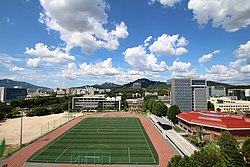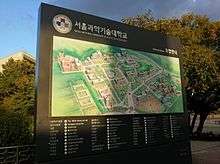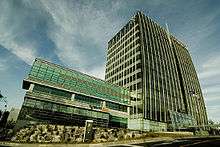Seoul National University of Science and Technology
Seoul National University of Science and Technology (abbreviated Seoultech) is a national university located in Nowon-gu, Seoul, South Korea.
 Campus of Seoultech | |
Former name | Seoul National Industrial University (1988–1993) Seoul National University of Technology (1993–2010)[1] |
|---|---|
| Motto | Your Future, Our Vision |
| Type | National |
| Established | 1906 |
| President | Lee, Dong-Hoon |
Academic staff | 789 (2019)[2] |
Administrative staff | 598 (2019)[2] |
| Students | 11,144 (2017)[2] |
| Undergraduates | 9,679 (2017)[2] |
| Postgraduates | 1,465 (2017)[2] |
| Location | , |
| Campus | Urban |
| Colors | Royal Blue |
| Nickname | SeoulGwagidae (서울과기대·서울科技大) |
| Mascot | Black Dragon |
| Website | www.seoultech.ac.kr |
| Seoul National University of Science and Technology | |
| Hangul | |
|---|---|
| Hanja | |
| Revised Romanization | Seoul Gwahak Gisul Daehakgyo |
| McCune–Reischauer | Sŏul Kwahak Kisul Taehakkyo |

Seoul National University of Science and Technology originated from Royal Engineering Research Center established in 1906(Gwangmu 10 ; Corea Empire since 1897) by Emperor Gojong's Royal Decree.[3] Later the school was re-organized as Gyeongseong Public Industrial School, Gyeonggi Technical College, and Seoul National University of Technology before it was finally reborn as Seoul National University of Science and Technology in September 2010 to celebrate the 100th anniversary of its foundation. The institution is also known as 'Seoultech'.
Today Seoultech is a large and general university housing six colleges, 23 departments, seven graduate schools and a student enrolment of 11,500 people in a spacious campus of 508,690 square meters (124 acres).[4] This is the fifth-largest campus in the universities of Seoul. The campus, formerly occupied by the colleges of engineering of Seoul National University,[5] is in Nowon-gu in the northern part of Seoul. Seoul National University of Science and Technology was ranked second in South Korea and 23rd in Asia in field of focused university in the 2015 by Quacquarelli Symonds (QS)[6][7] and ranked 15th in South Korea in the field of Science and Engineering in 2015 by Korea Economic Daily (한국경제신문).[8]
Departments
College of Engineering
- Department of Mechanical System and Design Engineering
- Mechanical Design and Automation Engineering Program
- Mechanical Design and Manufacturing Engineering Program
- Department of Mechanical & Automotive Engineering
- Mechanical Engineering Program
- Automotive Engineering Program
- Department of Safety Engineering
- Department of Materials Science & Engineering
- Department of Civil Engineering
- School of Architecture
- Architecture Program
- Architectural Engineering Program
College of Information and Communication Engineering
- Department of Electrical and Information Engineering
- Department of Electronic and IT Media Engineering
- Electronic Engineering Program
- Media IT Engineering Program
- Department of Computer Science and Engineering
College of Energy and Biotechnology
- Department of Chemical and Biomolecular Engineering
- Department of Environmental Engineering
- Environmental Engineering Program
- Environmental Policy Program
- Department of Food Science and Technology
- Department of Fine Chemistry
- Department of Optometry
- Department of Sports Science
College of Art and Design
- Department of Design
- Visual Communication Design Program
- Industrial Design Program
- Department of Ceramic Arts and Design
- Department of Metal arts & Design
- Department of Fine Arts
College of Humanities and Social Sciences
- Department of English Language and Literature
- Department of Science of Public Administration
- Major in Science of Public Administration
- Major in Environmental Public Administration
- Department of Creative Writing
College of Business and Technology
- Department of Industrial and Systems Engineering
- Major in Industrial and Information Systems Engineering
- Major in Manufacturing Systems and Design Engineering (MSDE)
- Major in IT Management (ITM)
- Department of Business Administration
- Major in Business Administration
- Major in Global Technology Management (GTM)
There are also three professional graduate schools and three special graduate schools within the university. Aside from these, there are a number of specialist research institutes.
Graduate school
- Master's Course, 2 years (4 semesters)
- Doctor's Course, 2 years (4 semesters)
- Engineering
Department of Mechanical Design and Robot Engineering Department of Mechanical Engineering Department of Safety Engineering Department of Product Design and Manufacturing Engineering Department of Data Science Department of Materials Science & Engineering Department of Automotive Engineering Department of Civil Engineering Department of Architectural Department of Electrical and Information Engineering Department of Electronic Engineering Department of Computer Science and Engineering Department of Media IT Engineering Department of Chemical Engineering Department of Environmental Engineering Department of Food Science and Technology Convergence Institute of Biomedical Engineering and Biomaterials Department of Interdisciplinary Bio IT Materials
- Science
Department of Fine Chemistry Department of Optometry
- Art and Physical
Department of Industrial Design Department of Visual Design Department of Ceramic Art Department of Metal Arts & Design Department of Fine Arts Department of Sports Science
- Humanities and Social Science
Department of Business Administration Department of English Language and Literature Department of Creative Writing
Professional Graduate School
- Master's Course, 2 years (4 semesters)
- Doctor's Course, two and a half years (5 semesters)
- Combined Master's and Doctorate program, 4 years (8 semesters)
- Graduate School of Railway
Department of Railway Management & Policy Department of Railway Construction Department of Electric & Signaling Engineering Department of Rolling Stock System Department of Railway System
- Graduate School of Public Policy and Information Technology
Department of Public Policy Department of Industrial & Information Systems Department of Broadcasting and Communication Policy Department of Digital & Cultural Policy
- Graduate School of Energy and Environment
Department of New Energy Engineering Department of Environmental Energy Engineering Department of Energy System Engineering Department of Energy Safety Engineering Department of Energy Policy
- Graduate School of Nano IT Design Fusion
Nano IT Fusion Program Broadcasting Communication Fusion Program IT Design Fusion Program
Special graduate schools
- Master's Course, 2 and a half years (5 semesters), at night
- Graduate School of Industry
Convergence Program of Healthcare & Biomedical Engineering Disaster Safety & Fire Protection Program Management of Technology Program Global Project Management Program Manufacturing Technology Convergence Program Department of Food Science and Technology Department of Civil Engineering Department of Architectural Design Department of Metal Art & Design
- Graduate School of Housing
Department of Housing Environment and Service Technology Department of Housing Construction Engineering Department of Housing Planning and Design Department of Housing Management Department of Housing Development and Management
Library
The library at Seoul National University of Science and Technology has been operational since the foundation of Eoeudong Public Vocational Continuing School in April 1910. Today, the Library has 600,987 volumes, 11,928 e-books, 23,259 audiovisual materials, and 446 periodicals and academic journals published domestically and abroad.[9]
The Central Library building, completed at the end of 2004, consists of three stories with an area of 9,281 m2 (2,807 pyeong). The first floor houses the library office, seminar rooms, Western archive, and information processing center. The second floor is occupied with Eastern archives and references, periodicals, and an academic journal room. The third floor houses a multimedia room, group study room, and reading room. The annex to Central Library, remodelled in 2011, is a building with an area of 4,896.25 m2 (1,400 pyeong) that is equipped with a reference room, reference room for western books, room for study groups, notebook computer reading room and general reading room. The library has collected academic research works of the professors and the students for the past 100 years.
Other support facilities

Aside from the library there is also an Information and Computer Center; a Press and Broadcasting Center; a General Laboratory Building; a Business Incubation Center; an Educational Equipment Management & Technical Support Center; and an International Office/ Centre for International Exchange. Finally, there is an Institute for Language Education and Research staffed by twenty native-speaking English instructors.
Scholarships

About half of the student body benefit from a scholarship program which offers education at a comparatively low cost. In 2015, about 6,000 of 11,500 students benefited from scholarship.[10] The school's current tuition only amounts to 40% of an average private university's costs and 80% of tuition fees charged by other national universities. In 2014, 47% of tuition was reused for scholarships. Seoultech also has a number of funded international cooperation programs, and two joint degree programs with Northumbria University in the United Kingdom.
The Institute for Language Education and Research
The Institute for Language Education and Research (ILER)[11] provides a variety of language programs to serve the University's English, Korean, Chinese and Japanese learning needs. There are currently 26 full-time faculty positions.[12] The ILER has a dedicated language center building which houses all needed facilities: professors' offices, administration offices, conference hall, conversation classrooms with round tables, etc. The ILER is a developing PLC (Professional Learning Community), focused on modernizing curriculum, expanding opportunities for research and publication, and fostering a spirit of intercultural exchange.
Symbols
In March 2014, the University's Public Relations Office held its first Symbolic Committee to determine its symbolism. Following the first questionnaire for teachers and faculty members in April 2013, we conducted a second questionnaire involving 12,807 undergraduate and graduate students in June 2013 in order to enact the symbol of university. The second questionnaire for undergraduate and graduate students who answered 91% of the total enrollment was Daesanbang, Sycamore, and Symbolic Animals. Haitai won the most votes.
Rankings
| QS National[13] | General | 35 |
|---|---|---|
| USNWR National[14] | General | 36 |
| QS Asia (Asian Ranking version)[15] | General | 271-280 |
| THE Asia[16] | General | 301-350 |
| USNWR Asia[17] | General | 330 |
| THE World[18] | General | 1001+ |
| QS World[19] | General | 801-1000 |
| USNWR World[20] | General | 1164 |
In 2018, Times Higher Education ranked the university within the 801–1000 band globally.
History

- 9 November 2015 – Inauguration of Jong-Ho Kim as 11th president
- 1 March 2012 – Seoul National University of Science and Technology, Technology University to Broad General University transition
- 25 October 2011 – Inauguration of Keun NamKoong as 10th president
- 1 September 2010 – Changed university name From Seoul National University of Technology to Seoul National University of Science & Technology
- 1 September 2010 – Completion of Centennial (100-year) Memorial Sculpture construction
- 1 February 2010 – Completion of Frontier hall construction
- 3 December 2009 – Completion of the construction of Centennial(100-year) Memorial Hall (start of the construction, 3 April 2007)
- 1 March 2008 – Opening of Graduate School of NID Fusion Technology
- 1 March 2008 – Completion of Seoul Techno Park(STP) construction[21]
- 1 January 2008 – Completion of Student Dormitory III construction
- 17 October 2007 – Inauguration of Jun-Hyong Roh as 9th president
- 1 October 2007 – Completion of Language Center construction
- 1 August 2007 – Completion of Student Dormitory II construction
- 1 June 2006 – Completion of Mirae Hall construction
- 1 September 2005 – Designation authorization of Seoul Technopark
- 25 February 2005 – Completion of Student Library II construction
- 17 December 2004 – Establishment authorization of Seoul Technopark Nonprofit Corporation
- 23 September 2004 – Foundation of Seoul Technopolis Promotion Center and Center for Engineering Education
- 26 March 2004 – Inauguration of Dr. Jin-Shin Yoon as 8th president
- 27 September 2003 – Establishment of SNUT Industry-Academic Alliance Corporation
- 23 September 2003 – Establishment authorization of Graduate School of Energy & Environment
- 21 April 2003 – Inauguration of Dr. Hee-Beom Lee as 7th president
- 1 March 2003 – Establishment of Graduate School of Public Policy & Information Technology
- 1 March 2002 – Change of Graduate School of Railroad Technology to Graduate School of Railroad (PhD Course)
- 24 February 2001 – Foundation of Graduate School of Housing
- 1 March 2000 – Foundation of Graduate School of Railroad Technology
- 1 March 2000 – Foundation of Department of English, Department of Creative Writing and Department of Social Sports Science (Daytime)
- Establishment a dual bachelor's dual program in collaboration with Northumbria University in the UK
- 1 April 1999 – Inauguration of Dr. Jin-Seol Lee as 6th president
- 2 April 1998 – Opening of Foreign Language Education Center
- 1 April 1998 – Opening of Laboratory Center
- 6 October 1995 – Foundation of Materials Science and Engineering, Graduate School of Industry & Engineering
- 1 April 1995 – Inauguration of Dr. Dong-Gyu Choi as 5th president
- 3 September 1994 – Foundation of Computer Science and Engineering, Graduate School of Industry & Engineering
- 1 March 1994 – Foundation of Department of Creative Writing and Department of Social Sports Science
- 1 March 1993 – Foundation of Design and Automobile Engineering and Automatic Chemical Engineering, Graduate School of Industry & Engineering
- 24 February 1993 – Renamed Seoul National University of Technology in accordance with the revision of national school establishment decree (Presidential Decree No. 13895, February 24, 1993)
- 24 November 1992 – Foundation of Industry Craft, Graduate School of Industry & Engineering. Completion of Dormitory construction
- 1 March 1992 – Foundation of Department of Industry Administration and Department of Fine Chemistry Foundation of School of Engineering III, School of Engineering IV and School of Humanities, Social and Natural Sciences
- 21 March 1991 – Inauguration of Prof. Dae-Byeong Yoon as 4th president
- 1 March 1990 – Foundation of School of Engineering I, School of Engineering II, School of Art & Design, and Department of Applied Fine Arts
- 15 November 1989 – Foundation of Electric Engineering, Chemical Engineering and Mechanical Design and Automation Engineering, Graduate School of Industry & Engineering
- 1 March 1988 – Renamed Seoul National Industrial University (Presidential Decree No. 1407, February 24, 1988)
- 21 March 1987 – Inauguration of Dr. Dong-Hee Lee as 3rd president
- 29 February 1984 – Foundation of Department of Environmental Engineering, Department of Industrial Safety Engineering, and Department of Mould Design
- 30 March 1983 – Inauguration of Dr. Ho-Keun Kim as 2nd president
- 31 December 1982 – Closing of Gyunggi Technical College in accordance with the revision of national school establishment decree
- March 1979 – Inauguration of Dr. Soon-Cheol Hong as 1st Dean
- March 1974 – Renamed Gyunggi Technical College
- March 1963 – Renamed Gyunggi Technical High Special School
- March 1953 – Renamed Gyunggi Technical High School
- March 1944 – Reorganized into Gyunggi Public Technical School
- March 1931 – Reorganized into Gyungsung Public Vocational School
- 15 April 1910 – Public Eoeudong Vocational Continuing School[22]
See also
References
- "HISTORY". SEOULTECH Official website. SEOULTECH. Retrieved 22 December 2018.
- "STATISTICS". SEOULTECH Official website. SEOULTECH. Retrieved 14 December 2018.
- "SEOULTECH < About SEOULTECH < Introduction of SEOULTECH < History < Main History". en.seoultech.ac.kr. Retrieved 2015-08-22.
- "SEOULTECH < About SEOULTECH < University Statistics < Statistics". en.seoultech.ac.kr. Retrieved 2015-08-22.
- "서울사랑". love.seoul.go.kr. Retrieved 2015-08-22.
- "[2014 아시아 대학평가] 醫大 없는 '强小大' 포스텍·서강대·한국외대 강세". Chosun.com. Retrieved 23 December 2017.
- "[2015 아시아 대학평가] 포스텍, 특성화 대학 중 1위… 6년 연속 아시아 최고 입증". Chosun.com. 11 June 2015. Retrieved 23 December 2017.
- "[STRONG KOREA] 서울대·연세대·고려대·한양대, 기업들이 꼽은 '최고의 이공계'". Hankyung.com. 5 July 2015. Retrieved 23 December 2017.
- "Seoultech Central Library(Korean)". library.seoultech.ac.kr. Retrieved 2015-08-22.
- "Seoultech, 3.35 billion dollars for national scholarship in 2015". www.seoultech.ac.kr. Retrieved 2015-08-22.
- The Institute for Language Education & Research
- "Institute for Language Education and Research, Seoultech". language.Seoultech.ac.kr. Retrieved 22 August 2015.
- "QS South Korea University Rankings 2019". Top Universities. 2019. Retrieved July 20, 2019.
- U.S.News & World Report (2019). "Search Best Global Universities - US News Education". U.S. News & World Report LP. Retrieved July 20, 2019.
- "QS Asian University Rankings". QS Quacquarelli Symonds Limited. 2019. Retrieved August 16, 2019.
- "Times Higher Education Asia University Rankings". Times Higher Education. 2019. Retrieved August 16, 2019.
- U.S.News & World Report (2019). "Best Global Universities in Asia - US News Education". U.S. News & World Report LP. Retrieved July 20, 2019.
- "THE World University Rankings". Times Higher Education. 2020. Retrieved October 19, 2019.
- "QS World University Rankings". QS Quacquarelli Symonds Limited. 2020. Retrieved August 16, 2019.
- U.S.News & World Report (2019). "Best Global Universities - US News". U.S. News & World Report LP. Retrieved July 20, 2019.
- "National Seoul Techno Park(STP) Homepage". SeoulTP.or.kr. Retrieved 23 December 2017.
- "서울과학기술대학교 - 주요연혁" [History of Seoultech]. www.seoultech.ac.kr (in Korean). Retrieved 2018-05-11.
External links
| Wikimedia Commons has media related to Seoul National University of Science and Technology. |